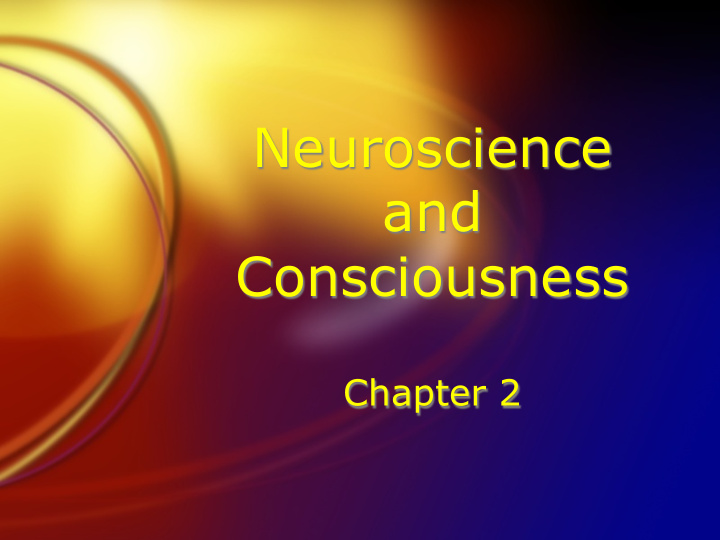



Neuroscience and Consciousness Chapter 2
Neurons Neuron cell – communication is electrical Axon Dendrites Mylin sheath Terminal buttons
Synapses Firing of neuron is electrical process All-or-none law Action potential Synapse – communication is chemical - Excitatory Inhibitory Lock and key concept Reuptake
Neurotransmitters GABA - inhibitory Dopamine - motor activity, behavior and cognition, memory Endorphins – pain reduction Serotonin – stress, alcoholism,mood, suicide, aggression, sleep, sexuality Acetylcholine – digestion, muscles Glutamate – memory -excitatory
Cellular Biology – Bruce Lipton, Ph.D. Single cells – analyze S from E Cellular communities – perceive E and organize = survival advantage Cooperation among groups of cells – gene transfer among species Genetic engineering - dangers
Cellular Biology – Environment Epigenetics – genes are not destiny –E can modify genes without changing their basic blueprint – changes are then passed onto future generations via proteins Cells are shaped by E E signal > DNA/RNA > protein Disease – cause is E, not cell
Cellular Biology – Membrane Membrane has 2 parts - Receptor proteins = tuned to specific E signals – physical signals; energy fields Effector proteins = appropriate life sustaining R – generate motor nerves Together they create a S-R mechanism Membrane – Is cell ’ s equivalent of a brain Functions like a computer chip Is programmable by E information
Cellular Biology – Nucleus Nucleus – a memory disk, hard drive containing DNA programs Data – entered into cell/computer via membrane receptors = cell ’ s ” keyboard ” Result : we have ability to edit data we enter into our biocomputers – we become masters of our fate, not victims of our genes. Behavior can be controlled by thot.
Nervous System Central Nervous System Peripheral Nervous System - Somatic division -Autonomic division Sympathetic system Parasympathetic system
Endocrine System Hormones - chemical messengers Adrenal glands - - Epinephrine - Norepinephrine Pituitary gland - Sends messages to other endocrine glands to release hormones when signaled by Hypothalamus – (master gland)
The Brain Major scanning techniques Older brain structures - Brainstem-medulla , pons Reticular formation Thalamus Cerebellum Limbic system Cerebral cortex - lobes
Regenerative powers Neuroplasticity Experience sculpts brain Neuroflexibility Flexibility of brain Neuroscaffolding Connections strengthened Neurogenesis – brain mends itself by producing new neurons
Lateralization Hemisphere functions Split brain
Film - Split Brain
The Mind - Siegel,M.D. Mind - Develops at interface of neurophysiological processes and interpersonal relationships Experience - Leads to firing of neurons which turns on genes which produces proteins Genes - Act as templates for information that is to be passes onto next generation Have a transcription function which determines which proteins will be synthesized
Matter and Energy – Lipton Matter made up of energy=spinning atoms Energetic signaling more efficient relaying E information than physical signals Every material structure radiates a unique energy signal
Matter and Energy – Lipton Universe is one indivisible, dynamic whole – an integration of interdependent energy fields Flow of information in a quantum universe is holistic
Matter and Energy – Lipton Redundant signaling pathways Iatrogenic illness Use of energy to heal brain Communication Thoughts consume energy - negative thinking drains energy
Brain Fingerprinting Dr. Farwell ’ s research – Subject wired with EEG Views screen - names, pictures Brain R with a murmur Tested FBI agents
Film – Brain Fingerprinting
Neuroscience and Consciousness: Review Names and functions of neurons, brain and nervous system Endocrine system = hormones Neuroplasticity; neuroscaffolding; neurogenesis Lateralization – split brain Lipton material: cellular microbiology; matter and energy; iatrogenic illness Siegel ’ s material – the mind Farwell – brain fingerprinting
Recommend
More recommend